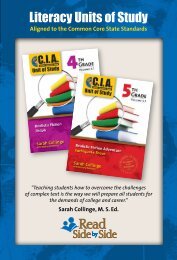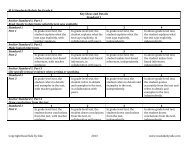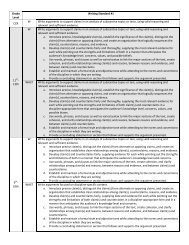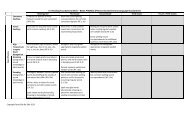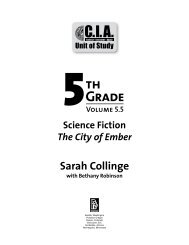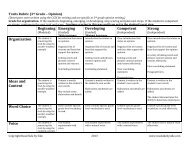Look Inside - Read Side By Side
Look Inside - Read Side By Side
Look Inside - Read Side By Side
You also want an ePaper? Increase the reach of your titles
YUMPU automatically turns print PDFs into web optimized ePapers that Google loves.
Welcome to the C. I. A. Unit of Study for the book HolesThis unit of study was put together for the purpose of teaching students how to read longer, morecomplex text. Unfortunately, in classrooms where only basal readers are used, many students donot learn how to make the transition from picture books, to series books, to more complex chapterbooks. As a result, students struggle during independent reading. This unit of study will teach studentsthe fundamental processes of reading text, specifically longer, more complex chapter books. Itfollows an approach described in its companion text, Raising the Standards through Chapter Books:The C. I. A. Approach. I hope you enjoy guiding your students through the authentic work of expertreaders!Holes, by Louis Sachar, is one of my all-time favorite books, and I have used it as a read-aloudin my classroom for years. It just gets better every time! The book connects well to the first unit inthe C. I. A. series for fifth grade, Earthquake Terror, because it continues to explore the genre realisticfiction. Students continue to learn that when reading realistic fiction it is important to focus onthe main character in order to determine the author’s message. In classrooms where the EarthquakeTerror unit was taught, students will recognize that, like Jonathan, Stanley has to change in order tosurvive harsh conditions.Holes was intentionally chosen as a read-aloud text for fifth grade because of its complex storystructure. Students who participated in the Earthquake Terror unit of study will build on theirknowledge of complex story structure as they read Holes. Throughout the book, Louis Sachar weavestogether five separate plots:1. Stanley’s story at Camp Green Lake (present)2. Stanley’s story of how he came to Camp Green Lake (past)3. The story of Stanley’s great-great-grandfather, Elya Yelnats4. The story of Stanley’s great-grandfather, Stanley Yelnats5. The story of Kissin’ Kate BarlowStudents will use small sticky note flags to mark Stanley’s Camp Green Lake story, Elya Yelnats’sstory, and Kissin’ Kate Barlow’s story.Throughout the lessons, students will analyze the connections across the various plots. They willlearn that a parallel plot is one that is completely separate from but informs another plot. The storyof Elya Yelnats will be mirrored in Stanley’s plot. Elya became physically stronger and more confidentjust as Stanley became physically stronger and more confident. Elya learned a lesson—that wecan choose our destiny. Stanley eventually learns this same lesson.The complexity of the text is also increased by the author’s artful use of dark humor to conveyseveral messages. Louis Sachar effectively uses sarcasm and irony in his portrayal of Camp GreenLake and its characters, and he addresses difficult topics in a humorous way that makes themapproachable.Key messages in this book:• We have the power to control our destiny.• Juvenile boot camps are ineffective.• We are cursed by stereotypes, if we choose to let them define us.Holes Unit of Study 5



